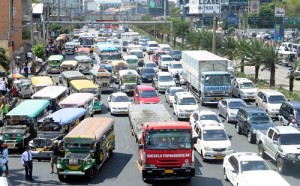Metro Manila residents on Monday got their first taste of a traffic nightmare that is likely to worsen and drag on for four years, city officials warned.
Several lanes of Metropolitan Manila’s main highways were closed starting last night as part of a series of road construction and upgrading projects for the city of about 12 million.
“We are informing the general public to brace for the traffic situation which we will be encountering for the next four years,” Francisco Manalo, executive director of the traffic office of the Metropolitan Manila Development Authority (MMDA) said as angry commuters took to social media to vent their frustrations.
Manalo warned that once construction began, vehicles on the city’s main roads would literally be reduced to crawling speed of one to nine kilometers an hour, compared to the already slow normal 20 kilometers per hour.
Motorists and commuters fearful of getting stuck on the
roads left home earlier than usual Monday.
But with so many vehicles on the road as the day began, traffic in and around Manila was snarled for hours on Monday morning.
“Traffic armageddon begins in Manila!!” tweeted San Crisselle Tiu, while Chay1007 said she had to bring “extra [supply] of patience.”
Once actual construction begins, it could take a vehicle at least two hours to travel the 19-kilometre stretch down the city’s main thoroughfare, warned Vicente Lizada, spokesman for the MMDA’s traffic monitoring office.
The authority has asked contractors to provide staff to help direct traffic.
Manalo said they are also looking at alternatives such as using the Pasig River for commuter traffic even though the last river ferry closed down in 2011 due to low income.
The MMDA said the traffic jams will prod more commuters to travel by rail.
MMDA Traffic Engineering Center (TEC) Director Neomi Recio however fears that the Light Railway System (LRT) and the Metro Railway System (MRT) may be unable to cope with the influx of passengers.
“Definitely, more commuters will now use the MRT and LRT. Our only problem is that the capacity of the existing coaches might not able to cope with the influx of additional passengers,” she said.
Because of this, the MMDA urged the Department of Transportation and Communications (DOTC) to increase the number of coaches and if possible, extend the operating hours of the railway systems.
Four-day workweek
The looming traffic scenario also prompted labor organizations to back the proposed four-day workweek and the imposition of a flexible work time.
Renato Magtubo, chairman of the Partido ng Manggagawa (PM) said his group supports the implementation of any “flexible work arrangements” provided that the welfare of workers will not suffer in the long run.
“We support flexible arrangements given the realties brought about by government infrastructure programs that in the long term will benefit the public,” Magtubo said.
However, he noted that workers should first be consulted.
“Labor standards should not be violated, and ample support should be provided by the employers to the additional burden or risks that the employees may endure in complying with flexible work arrangements,” he added.
Josua Mata, Secretary General of the Alliance of Progressive Labor said any changes should not undermine workers’ rights and welfare.
He said a four-day-work week and other similar schemes “must not lead to lower pay.”
A federation of private schools on Monday also suggested that schools come out with short and long range programs to deal with the traffic problems.
Eleazardo Kasilag, president of the Federation of Associations of Private Schools and Administrators, said public and private schools should implement car pooling system.
“It should include the students and the teachers as well as the school administrators. The schools need only to issue a memorandum to implement this,” Kasilag said.
The Department of Education and the Commission on Higher Education are studying the proposal to implement a similar four-day school week.


